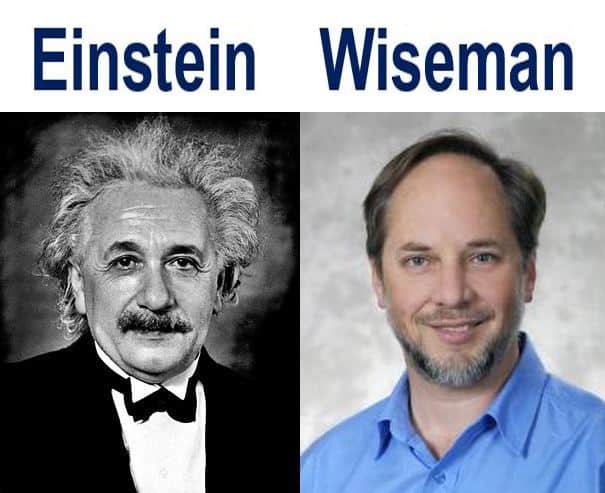Albert Einstein, who believed a particle could only be detected at one point, said he could not support the strange theory that the measurement of a particle affected its location. Australian and Japanese scientists say he was wrong – this ‘spooky action at a distance’ takes place in a photon.
Professor Howard Wiseman, who works at the Centre for Quantum Dynamics at Griffith University in Australia, and researchers from the University of Tokyo, made measurements to demonstrate what Einstein said was impossible – the non-local collapse of the ‘wave function’ of a particle.
Quantum mechanics (mathematical description of the motion and interaction of subatomic particles) says that a single particle may be described by a wave function that spreads over long distances, but cannot be detected in more than one place.
Prof. Wiseman and colleagues wrote about their findings in the academic journal Nature Communications (citation below).

Wiseman says that Einstein was wrong eighty-eight years ago.
This phenomenon, which is explained by quantum theory, was refuted in 1927 by Einstein as ‘spooky action at a distance.’
Collapse of a wave function
Quantum mechanics says that a single particle can be described by a wave function. Although it may be spread over long distances, it is never detected in more than one place. Scientists say this is because the Universe behaves like a little probability wave.
They say particles are in several places simultaneously, each with some probability.
So, if an electron was fired through two slits at a screen, this means it would pass through both of them.
However, when a pair of cameras are set up to monitor the slits, the wave function collapses – and does not go through both slits, but just one of them.
Einstein said the phenomenon was impossible
Einstein said the phenomenon violated the theory of relativity, which says that information can only travel up to the speed of light.
Eighty-eight years later, Prof. Wiseman and colleagues demonstrated that the collapse of the wave function is a real effect by splitting a single photon. They used homodyne detectors which measure frequency-modulated radiation (wave-like properties).
Previous experiments have shown that interaction between two quantum particles occurs faster than light-speed, however, the researchers emphasized that it is impossible to use it to send information.
Those experiments demonstrated entanglement with two particles. In this latest study, a photon entangled with itself.
Best proof yet
It is the most compelling proof so far of the entanglement of a single particle, an enigmatic form of quantum entanglement that scientists are researching into for computation and quantum communication.
In an interview with Live Science, Prof. Wiseman said:
“Einstein never accepted orthodox quantum mechanics and the original basis of his contention was this single-particle argument. This is why it is important to demonstrate non-local wave function collapse with a single particle.”
“Einstein’s view was that the detection of the particle only ever at one point could be much better explained by the hypothesis that the particle is only ever at one point, without invoking the instantaneous collapse of the wave function to nothing at all other points.”
“However, rather than simply detecting the presence or absence of the particle, we used homodyne measurements enabling one party to make different measurements and the other, using quantum tomography, to test the effect of those choices.”
“Through these different measurements, you see the wave function collapse in different ways, thus proving its existence and showing that Einstein was wrong.”
Citation: “Experimental proof of nonlocal wavefunction collapse for a single particle using homodyne measurements,” Maria Fuwa, Shuntaro Takeda, Marcin Zwierz, Howard M. Wiseman & Akira Furusawa. Nature Communications. Published 24 March, 2015. DOI: 10.1038/ncomms7665.

